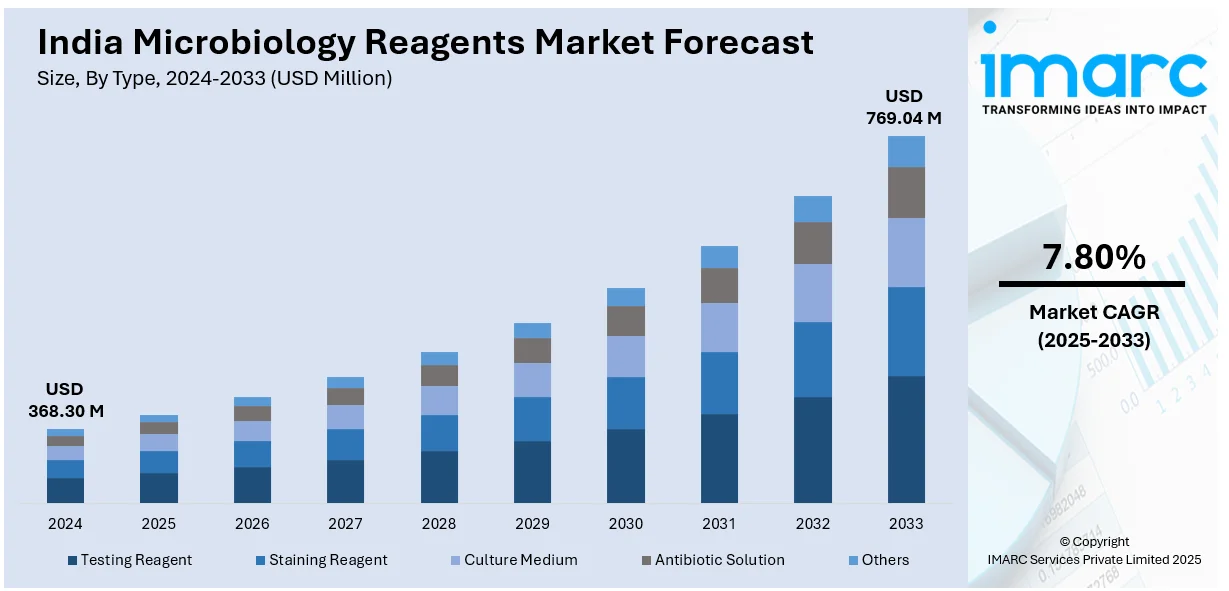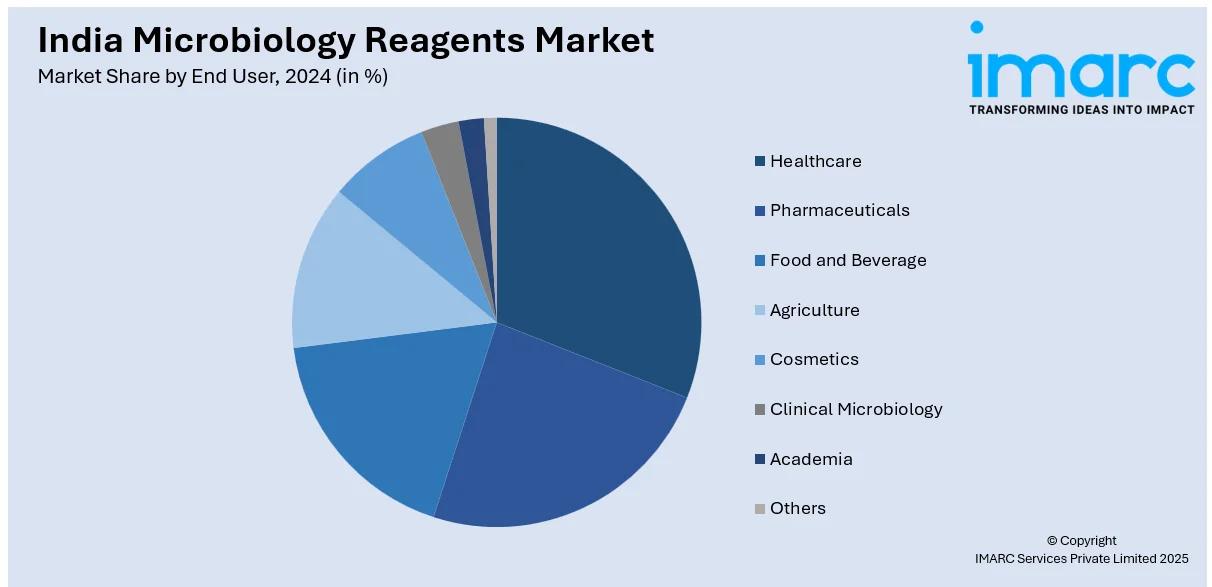
India Microbiology Reagents Market Size, Share, Trends and Forecast by Type, Type of Reagent, Product Type, End User, and Region, 2025-2033
India Microbiology Reagents Market Overview:
The India microbiology reagents market size reached USD 368.30 Million in 2024. Looking forward, IMARC Group expects the market to reach USD 769.04 Million by 2033, exhibiting a growth rate (CAGR) of 7.80% during 2025-2033. The India microbiology reagents market share is expanding, driven by the rising need for reliable diagnostic tests to detect various pathogens, along with increasing investments in infectious disease research, promoting the usage of reagents in culture media.
|
Report Attribute
|
Key Statistics
|
|---|---|
|
Base Year
|
2024 |
|
Forecast Years
|
2025-2033
|
|
Historical Years
|
2019-2024
|
| Market Size in 2024 | USD 368.30 Million |
| Market Forecast in 2033 | USD 769.04 Million |
| Market Growth Rate 2025-2033 | 7.80% |
India Microbiology Reagents Market Trends:
Growing incidence of infectious diseases
The rising prevalence of infectious diseases is fueling the India microbiology reagents market growth. With an increasing number of cases of bacterial, viral, and fungal infections, healthcare facilities, diagnostic labs, and research institutions are relying on microbiology reagents for accurate identification and analysis. According to the information published on the official website of the World Health Organization (WHO), from early June to 15 August 2024, the Ministry of Health and Family Welfare of the Government of India documented 245 instances of acute encephalitis syndrome (AES), which included 82 fatalities (CFR 33%). Of these, 64 cases of infection caused by the Chandipura virus (CHPV) were verified. As diseases like tuberculosis, dengue, and antimicrobial-resistant infections continue to spread, the demand for high-quality microbiology reagents is rising to support early detection and effective treatment. Additionally, increasing awareness about the importance of timely diagnosis is motivating hospitals and laboratories to broaden their microbiology testing capabilities. With advancements in diagnostic technologies, there is a shift toward automated and rapid testing solutions, which require reliable and high-performance microbiology reagents. As a result, the market is experiencing steady growth, owing to the urgent need for efficient disease surveillance, outbreak management, and refined patient care in India.

To get more information on this market, Request Sample
Increasing research and development (R&D) activities
The rise in R&D activities is offering a favorable India microbiology reagents market outlook. With a growing focus on antimicrobial resistance and biotechnology advancements, R&D labs and pharmaceutical companies are wagering on microbiological studies. These activities require high-quality reagents for testing, culturing, and analyzing microorganisms, leading to a steady increase in demand. Universities and research institutions are also expanding their microbiology programs, conducting studies on emerging pathogens, vaccine development, and drug resistance, further creating the need for specialized reagents. Additionally, government initiatives and private investments in biotech startups and healthcare innovations are creating opportunities for new product development in the microbiology sector. In FY2024-25 Budget, the Department of Health Research in India was awarded an enhanced budget of 13% (INR 3,301 Crore) compared to 2023 to bolster the Indian Council of Medical Research, implement various central sector initiatives, and develop human resource capabilities. The rise of molecular diagnostics and precision medicine is also promoting the utilization of advanced microbiology reagents that offer faster and more accurate results. As laboratories continue to explore new treatments and diagnostic methods, the market in India is set to expand.
India Microbiology Reagents Market Segmentation:
IMARC Group provides an analysis of the key trends in each segment of the market, along with forecasts at the regional level for 2025-2033. Our report has categorized the market based on type, type of reagent, product type, and end user.
Type Insights:
- Testing Reagent
- Staining Reagent
- Culture Medium
- Antibiotic Solution
- Others
The report has provided a detailed breakup and analysis of the market based on the type. This includes testing reagent, staining reagent, culture medium, antibiotic solution, and others.
Type of Reagent Insights:
- Silica gel
- Agar Powder
- Gelatin Powder
- Others
A detailed breakup and analysis of the market based on the type of reagent have also been provided in the report. This includes silica gel, agar powder, gelatin powder, and others.
Product Type Insights:
- Pathogen Specific Kits
- General Kits
The report has provided a detailed breakup and analysis of the market based on the product type. This includes pathogen specific kits and general kits.
End User Insights:

- Healthcare
- Pharmaceuticals
- Food and Beverage
- Agriculture
- Cosmetics
- Clinical Microbiology
- Academia
- Others
A detailed breakup and analysis of the market based on the end user have also been provided in the report. This includes healthcare, pharmaceuticals, food and beverage, agriculture, cosmetics, clinical microbiology, academia, and others.
Regional Insights:
- North India
- South India
- East India
- West India
The report has also provided a comprehensive analysis of all the major regional markets, which include North India, South India, East India, and West India.
Competitive Landscape:
The market research report has also provided a comprehensive analysis of the competitive landscape. Competitive analysis such as market structure, key player positioning, top winning strategies, competitive dashboard, and company evaluation quadrant has been covered in the report. Also, detailed profiles of all major companies have been provided.
India Microbiology Reagents Market News:
- In January 2024, QIAGEN revealed the introduction of ‘QIAstat-Dx’ syndromic tests in India for swift and precise identification of infectious diseases. The system was intended for laboratory use and utilized economical single-use cartridges that contained all necessary reagents and incorporated sample processing features.
- In December 2024, the government of Telangana initiated a special 100-day effort for TB eradication. The initiative sought to pinpoint individuals at risk of TB across multiple districts and execute screenings. To streamline the procedure, the mobile units were outfitted with cutting-edge digital X-ray devices and CB-NAAT equipment for testing. The state government guaranteed that sufficient testing reagents and medications were accessible for the program.
India Microbiology Reagents Market Report Coverage:
| Report Features | Details |
|---|---|
| Base Year of the Analysis | 2024 |
| Historical Period | 2019-2024 |
| Forecast Period | 2025-2033 |
| Units | Million USD |
| Scope of the Report |
Exploration of Historical Trends and Market Outlook, Industry Catalysts and Challenges, Segment-Wise Historical and Future Market Assessment:
|
| Types Covered | Testing Reagent, Staining Reagent, Culture Medium, Antibiotic Solution, Others |
| Type of Reagents Covered | Silica gel, Agar Powder, Gelatin Powder, Others |
| Product Types Covered | Pathogen Specific Kits, General Kits |
| End Users Covered | Healthcare, Pharmaceuticals, Food and Beverage, Agriculture, Cosmetics, Clinical Microbiology, Academia, Others |
| Regions Covered | North India, South India, East India, West India |
| Customization Scope | 10% Free Customization |
| Post-Sale Analyst Support | 10-12 Weeks |
| Delivery Format | PDF and Excel through Email (We can also provide the editable version of the report in PPT/Word format on special request) |
Key Benefits for Stakeholders:
- IMARC’s industry report offers a comprehensive quantitative analysis of various market segments, historical and current market trends, market forecasts, and dynamics of the India microbiology reagents market from 2019-2033.
- The research report provides the latest information on the market drivers, challenges, and opportunities in the India microbiology reagents market.
- Porter's five forces analysis assist stakeholders in assessing the impact of new entrants, competitive rivalry, supplier power, buyer power, and the threat of substitution. It helps stakeholders to analyze the level of competition within the India microbiology reagents industry and its attractiveness.
- Competitive landscape allows stakeholders to understand their competitive environment and provides an insight into the current positions of key players in the market.
Key Questions Answered in This Report
The microbiology reagents market in the India was valued at USD 368.30 Million in 2024.
The India microbiology reagents market is projected to exhibit a CAGR of 7.80% during 2025-2033, reaching a value of USD 769.04 Million by 2033.
The India microbiology reagents market is growing with increasing disease incidence, expanding diagnostic laboratory capacity, and pharma research. Increased awareness of infectious diseases, better healthcare infrastructure, and increasing research and development (R&D) spending on biotechnology and life sciences drive market demand. Demand for culture medium, stains, and reagents also gets a boost with the increasing adoption of microbial detection technologies.
Need more help?
- Speak to our experienced analysts for insights on the current market scenarios.
- Include additional segments and countries to customize the report as per your requirement.
- Gain an unparalleled competitive advantage in your domain by understanding how to utilize the report and positively impacting your operations and revenue.
- For further assistance, please connect with our analysts.
 Request Customization
Request Customization
 Speak to an Analyst
Speak to an Analyst
 Request Brochure
Request Brochure
 Inquire Before Buying
Inquire Before Buying




.webp)




.webp)












